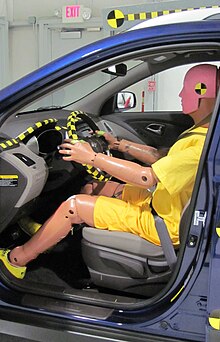Our website is made possible by displaying online advertisements to our visitors.
Please consider supporting us by disabling your ad blocker.
Automotive safety

Automotive safety is the study and practice of automotive design, construction, equipment and regulation to minimize the occurrence and consequences of traffic collisions involving motor vehicles. Road traffic safety more broadly includes roadway design.
One of the first formal academic studies into improving motor vehicle safety was by Cornell Aeronautical Laboratory of Buffalo, New York. The main conclusion of their extensive report is the crucial importance of seat belts and padded dashboards.[1] However, the primary vector of traffic-related deaths and injuries is the disproportionate mass and velocity of an automobile compared to that of the predominant victim, the pedestrian.[citation needed]
According to the World Health Organization (WHO), 80% of cars sold in the world are not compliant with main safety standards. Only 40 countries have adopted the full set of the seven most important regulations for car safety.[2]
In the United States, a pedestrian is injured by a motor vehicle every 8 minutes, and are 1.5 times more likely than a vehicle's occupants to be killed in a motor vehicle crash per outing.[3]
Improvements in roadway and motor vehicle designs have steadily reduced injury and death rates in all first world countries. Nevertheless, auto collisions are the leading cause of injury-related deaths, an estimated total of 1.2 million in 2004, or 25% of the total from all causes. Of those killed by autos, nearly two-thirds are pedestrians.[4] Risk compensation theory has been used in arguments against safety devices, regulations and modifications of vehicles despite the efficacy of saving lives.[5]
Coalitions to promote road and automotive safety, such as Together for Safer Roads (TSR), brings together global private sector companies, across industries, to collaborate on improving road safety. TSR brings together members' knowledge, data, technology, and global networks to focus on five road safety areas that will make an impact globally and within local communities.[6]
The rising trend of autonomous things is largely driven by the move towards the autonomous car, that both addresses the main existing safety issues and creates new issues. The autonomous car is expected to be safer than existing vehicles, by eliminating the single most dangerous element - the driver. The Center for Internet and Society at Stanford Law School claims that "Some ninety percent of motor vehicle crashes are caused at least in part by human error".[7] But while safety standards like the ISO 26262 specify the required safety, it is still a burden on the industry to demonstrate acceptable safety.
- ^ Making the Death Seat Safer Popular Science July 1950
- ^ "OMS | 10 faits sur la sécurité routière dans le monde". WHO. Archived from the original on August 10, 2009.
- ^ "Injury Prevention and Control: Motor Vehicle Safety". Center for Disease Control and Prevention. Retrieved 2012-03-20.
- ^ "World Health Organization: World report on road traffic injury prevention (2004)". Who.int. 2010-12-12. Retrieved 2011-09-20.
- ^ MacKay, M (1985). "Seat belts and risk compensation". BMJ. 291 (6498): 757–758. doi:10.1136/bmj.291.6498.757. PMC 1419041. PMID 3929928.
- ^ "About Us – TogetherForSaferRoads". togetherforsaferroads.org. Archived from the original on 2019-11-05. Retrieved 2016-11-07.
- ^ "Human error as a cause of vehicle crashes". cyberlaw.stanford.edu. Retrieved April 18, 2017.
Previous Page Next Page


